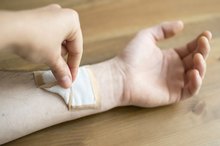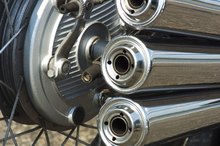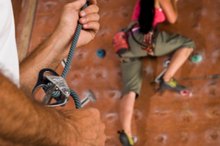How to Remove Wound Packing Painlessly
Cuts and wounds are an unfortunate part of life. Removing bandages from wounds is a painful task that can sometimes hurt as much as the injury itself. The pain comes from the wound packing becoming dry and sticking to your skin. You can ease some of the pain by knowing how to properly remove the wound packing. All it requires is some pain medicine, saline solution and a little patience.
Take some aspirin or other pain medicine at least a half hour before attempting to remove the wound packing.
How to Remove Gauze That Sticks to Wounds
Learn More
Stand over a sink or bathtub.
Pour some saline solution or contact lens solution over the wound packing. Let the solution soak into the packing for about 10 minutes to loosen up the gauze, glue and other elements of the packing.
How to Use Micropore Tape on a Scar
Learn More
Pull the tape slowly that holds the wound packing in place. Take your time, and pull each piece of tape completely free from the gauze and your skin.
Pull the gauze packing slowly from your skin. Lift and pull, then lift and pull again until the gauze is completely removed.
Dispose of the old wound packing. Let your wound get some air for a few minutes.
Wet a clean cloth with warm water, and wipe the wound area.
Dry the wound area by patting it. Do not rub the area.
Tips
Remove the wound packing slowly, and observe the wound area. Check for any discoloration, an odd discharge, extreme pain or strange smell. Contact your physician, or visit a minor medical/emergency room for medical attention.
Warnings
Do not use a harsh soap or other chemical to clean your wound area. Use only clean gauze when repacking the wound area.
Related Articles
References
- Mccaughan D, Sheard L, Cullum N, Dumville J, Chetter I. Patients' perceptions and experiences of living with a surgical wound healing by secondary intention: A qualitative study. Int J Nurs Stud. 2018;77:29-38. doi:10.1016/j.ijnurstu.2017.09.015
- Krafts KP. Tissue repair: The hidden drama. Organogenesis. 2010;6(4):225-33. doi:10.4161/org.6.4.12555
- Chetter IC, Oswald AV, Fletcher M, Dumville JC, Cullum NA. A survey of patients with surgical wounds healing by secondary intention; an assessment of prevalence, aetiology, duration and management. J Tissue Viability. 2017;26(2):103-107. doi:10.1016/j.jtv.2016.12.004
- Singh PK, Saxena N, Poddar D, et al. Comparative Study Of Wound Healing In Primary Versus Delayed Primary Closure In Contaminated Abdominal Surgery. Hellenic J Surg. 2016;88:314–320. doi:10.1007/s13126-016-0340-8
- Surgical Patient Education Program: Prepare for the Best Recovery. American College of Surgeons. 2018.
- Rushbrook JL, White G, Kidger L, Marsh P, Taggart TF. The antibacterial effect of 2-octyl cyanoacrylate (Dermabond®) skin adhesive. J Infect Prev. 2014;15(6):236-239. doi:10.1177/1757177414551562
- Lazar HL, Mccann J, Fitzgerald CA, Cabral HJ. Adhesive strips versus subcuticular suture for mediansternotomy wound closure. J Card Surg. 2011;26(4):344-7. doi:10.1111/j.1540-8191.2011.01257.x
- 3M Wound Resource Center. http://solutions.3m.co.uk/wps/portal/3M/en_GB/skin-care/wound-resource-centre/
Warnings
- Do not use a harsh soap or other chemical to clean your wound area.
- Use only clean gauze when repacking the wound area.
Writer Bio
Nick Davis is a freelance writer specializing in technical, travel and entertainment articles. He holds a bachelor's degree in journalism from the University of Memphis and an associate degree in computer information systems from the State Technical Institute at Memphis. His work has appeared in "Elite Memphis" and "The Daily Helmsman" in Memphis, Tenn. He is currently living in Albuquerque, N.M.








